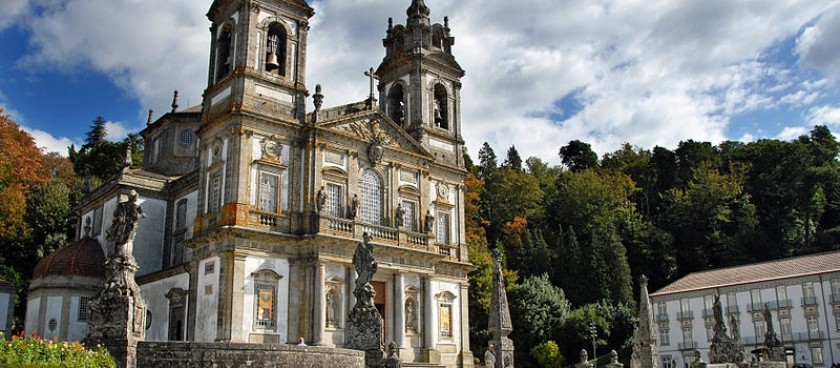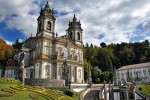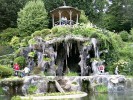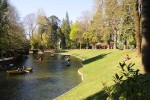- #PT01
- Estrada do Bom Jesus, 4715-056 Tenões, Portugal
- +351253676636
- basilica@bomjesus.pt
- http://bomjesus.pt
- Working hours*:
9:00 - 19:00 - * - opening and closing times as well as entrance prices, are subject to alterations without notice. Visitors are advised to check before visiting.
- 41.5547650, -8.3770510 Copy to clipboard Copy
-
#Churches , #Parks
Spectacular sanctuary of Bom Jesus do Monte is itting on the hilltop, 116 meters ( 381 feet ) high, it’s an important pilgrimage site and one of the most photographed churches in the world. Very recently, the spectacular sanctuary became the UNESCO World Heritage Site. When you visit, you’ll see that this is well deserved.
The chances are that if you ever came across images of Bom Jesus in Braga, it was the Baroque stairway that caught your attention. The dark granite and white plaster staircase zigzags all the way to the top, leading to the church. Both the staircase and the church were commissioned by Archbishop of Braga in 1722. If you are traveling through Northern Portugal or are based in Porto for a few days, adding a visit to Bom Jesus is simply a must.
Staircase
Even though you’re climbing the stairs towards the church, it’s the beautiful staircase, that is the highlight of the visit. I found it surprising how many people skip that part and head straight to the top via funicular, missing out on what I think is the biggest highlight of visiting Bom Jesus. Even though the climb involves lots of steps, the stairway is simply stunning, with many fountains and statues with a symbolical meaning attached to them, so typical for a religious site.
The staircase is divided into two parts. The first, bottom part is Stairway of Five Senses ( Escadaria do Cinco Sentidos ) with 5 fountains dedicated to 5 senses: touch, smell, taste, sight and sound. The bottom of this part is also where you get the famous, spectacular view of the perfectly symmetrical zigzag staircase and the church on top.
The second part of the climb is the Escadaria das Tres Virtudes, with 3 fountains dedicated to the Three Theological Virtues: Faith, Hope and Charity.
One of the best things about climbing the steps are the stunning views, especially on your way down. There are a few platforms along the way, where you can stop and admire the breathtaking views of Braga and the mountains.
Speaking of the steps. There are quite a few of them to conquer before you reach the top of the hill. 577 total to be precise, if you count from the main entrance. The first 300 steps are wide, less steep and easily manageable. Along the way you’ll pass a few chapels, before you end up at the bottom of Stairway of Five Senses, which is where the zigzag staircase starts. From there it gets steeper, but there are a few platforms to stop, take a little rest and admire the views around.
The church
While the beautiful staircase is the most impressive part of Bom Jesus, the church at the top of the hill is also worth a visit. Especially after you climbed more than 500 steps to get there. Built 1784 and 1834, it’s a great example of Neoclassical style. The highlight of the church is the main altar depicting the crucifixion scene.
Park and gardens
The grounds surrounding the sanctuary are quite expansive with beautiful gardens and forest. If you walk behind the church there are a few trails, a lagoon and some good look out points to the West of Braga.
There’s also an outdoor cafe with a nice view, that serves coffee, snacks and beer.
Bom Jesus Funicular
If climbing the steps is absolutely out of the question, there is a way to get to the top in just 3 minutes without the workout. All thanks to an antique funicular, that runs from the bottom all the way to the top. This is actually an experience in itself. The funicular, built in 1882, it’s entirely powered by water. It runs daily from 8 am -8 pm, and a single trip costs € 1,50 ( € 2,50 round trip ). This is also a great option for people with any kind of mobility issues.
If this is how you choose to reach the top of the hill, keep in mind that the funicular goes all the way to the top. So in order to enjoy the famous view of the zigzag staircase, you’ll have to descend 250 steps.
History
Many hilltops in Portugal and other parts of Europe have been sites of religious devotion since antiquity, and it is possible that the Bom Jesus hill was one of these. However, the first indication of a chapel over the hill dates from 1373. This chapel - dedicated to the Holy Cross - was rebuilt in the 15th and 16th centuries. In 1629 a pilgrimage church was built dedicated to the Bom Jesus (Good Jesus), with six chapels dedicated to the Passion of Christ.
The present Sanctuary started being built in 1722, under the patronage of the Archbishop of Braga, Rodrigo de Moura Telles. His coat of arms is seen over the gateway, in the beginning of the stairway. Under his direction the first stairway row, with chapels dedicated to the Via Crucis, were completed. Each chapel is decorated with terra cotta sculptures depicting the Passion of Christ. He also sponsored the next segment of stairways, which has a zigzag shape and is dedicated to the Five Senses. Each sense (Sight, Smell, Hearing, Touch, Taste) is represented by a different fountain. At the end of this stairway, a Baroque church was built around 1725 by architect Manuel Pinto Vilalobos.
The works on the first chapels, stairways and church proceeded through the 18th century. In an area behind the church (the Terreiro dos Evangelistas), three octagonal chapels were built in the 1760s with statues depicting episodes that occur after the Crucifixion, like the meeting of Jesus with Mary Magdalene. The exterior design of the beautiful chapels is attributed to renowned Braga architect André Soares. Around these chapels there are four Baroque fountains with statues of the Evangelists, also dating from the 1760s.
Around 1781, archbishop Gaspar de Bragança decided to complete the ensemble by adding a third segment of stairways and a new church. The third stairway also follows a zigzag pattern and is dedicated to the Three Theological Virtues: Faith, Hope and Charity, each with its fountain. The old church was demolished and a new one was built following a Neoclassic design by architect Carlos Amarante. This new church, began in 1784, had its interior decorated in the beginning of the 19th century and was consecrated in 1834. The main altarpiece is dedicated to the Crucifixion.
Significance
The design of the Sanctuary of Bom Jesus, with its Baroque nature emphasised by the zigzag form of its stairways, influenced many other sites in Portugal (like Lamego) and colonial Brazil, like the Sanctuary of Congonhas. As the pilgrims climbed the stairs, (by tradition encouraged to do so on their knees) they encountered a theological programme that contrasted the senses of the material world with the virtues of the spirit, at the same time as they experienced the scenes of the Passion of Christ. The culmination of the effort was the temple of God, the church on the top of the hill. The presence of several fountains along the stairways give the idea of purification of the faithful.
The new church (built 1784–1834) by Carlos Amarante was one of the first Neoclassic churches of Portugal.
This church was elevated to a Minor Basilica status on 5 July 2015 by Pope Francis.
In the 19th century, the area around the church and stairway was expropriated and turned into a park. In 1882, to facilitate the access to the Sanctuary, the water balance Bom Jesus funicular was built linking the city of Braga to the hill. This was the first funicular to be built in the Iberian Peninsula and is still in use.
The Sanctuary has been classified as Property of Public Interest since 1970.




